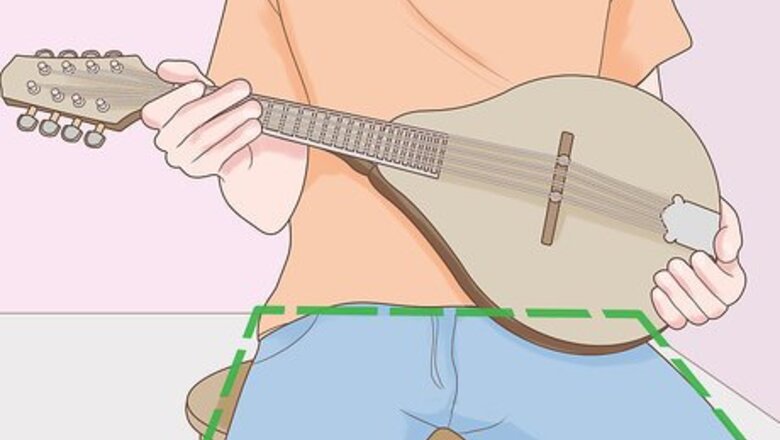
views
X
Research source
When learning how to play, you should practice playing single notes and simple chords before moving onto full songs. With the right amount of practice, you'll be strumming beautiful tunes on your mandolin in no time!
Setting up the Mandolin
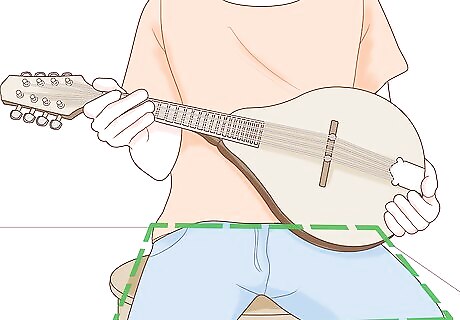
Hold your mandolin in your lap. Straighten your back and square your shoulders while you play. Don't hunch over. Place the mandolin's body on top of your leg and hold the neck of the instrument with your left hand. The back of the mandolin should be pressed against your stomach. You should feel comfortable and your muscles shouldn't feel strained or tense. You can use a shoulder strap to keep the mandolin in place as you play. The neck of the mandolin should be angled slightly upwards. This will make fingering easier.
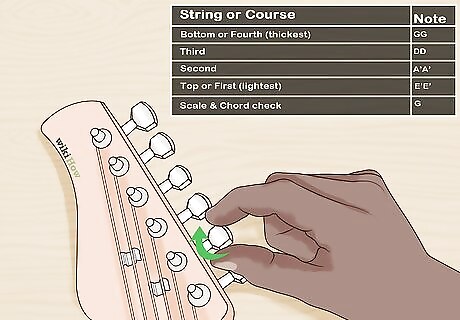
Tune your mandolin to the standard tuning. The notes for each string in standard tuning, from bottom to top, should be E, E, A, A, D, D, and G, G. Turn on your electronic tuner and strum the bottom string. Turn the tuning knob at the top of your mandolin's neck until the bottom string plays an E. Continue to do this with all the strings until your mandolin is in tune. The strings of a mandolin are tuned in pairs. When you play, you'll hold down both strings in each pair. Use a standard mandolin tuner to tune your mandolin. If not immediate access to a mandolin tuner, a violin tuner will do as well, since violins and mandolins are tuned to the same notes. Your tuner should have a needle that shows you what note you're playing or a light that will come on when the strings are in tune. The bottom strings on your mandolin, or the E strings, are called the “top” strings because they play the highest octave.
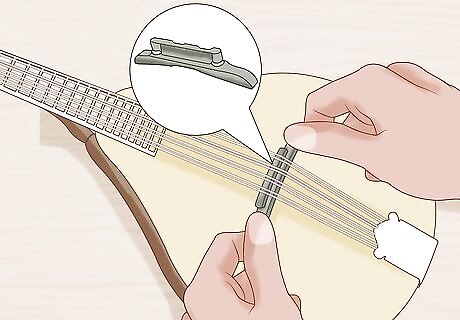
Adjust the strings to a low action. A high action means that the strings are higher off the fretboard and can make pushing down the strings and creating a good sound difficult for newer players. Place a nickel in between the strings and the neck on the twelfth fret. Then, adjust the knobs on the bridge until the distance between the strings and the neck is a nickel's width. The bridge is the part of your mandolin where the strings connect to the instrument's body. You'll have to adjust the action for both the top four and the bottom four strings.

Purchase a heavy pick. A heavy pick is thick while a light pick is thin and will bend while you play. Playing with a light pick will make it harder to create clear sounding notes and chords with the mandolin and should be avoided. Light picks are between .45 mm and .7 mm in thickness. Heavy picks are between .85 mm and 1.20 mm in thickness.
Playing Notes

Strum the mandolin without holding down the strings. Hold your pick in your right hand, between your thumb and index finger. Flick your wrist so that the tip of the pick hits the strings between the bridge and the neck of the mandolin. Strum the first set of strings then move down to the second set of strings. Practice strumming over different strings until you feel confident strumming. Holding the pick too tightly will create a more metallic sound.
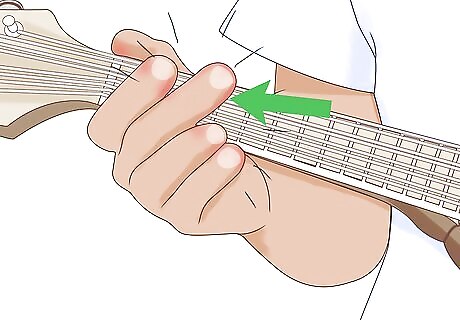
Press down on the strings and strum. Your thumb should be on the top or back of the mandolin's neck while your four fingers rest over the strings. Press down hard on a fret with the tips of your fingers, then strum with your other hand. Continue to do this until you can get a clear note that doesn't buzz or hum. Your fingertips should be pushing down on both strings in the pair. Aim your fingers so that they press down closer to the edge of the fret. This will produce a clearer sound than if you held down the middle of the fret.
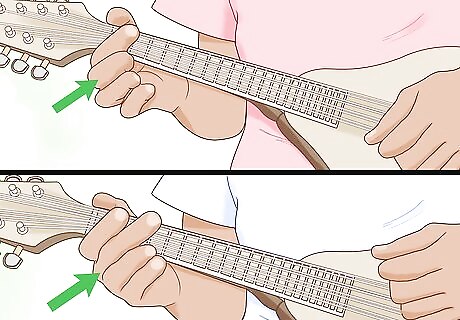
Hold down different frets with different fingers. Hold down the second fret on the top string with your pointer finger and strum. Then, lift off the string and hold down the fourth fret with your middle finger. Practice going back and forth between the notes until you feel comfortable. This will help you transition between notes and develop your playing speed with your left hand.
Strumming Basic Chords
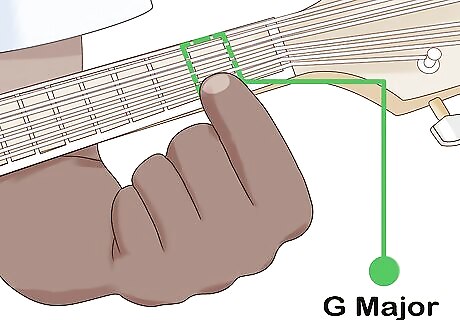
Play a G major. A G major is one of the three most popular chords to play on the mandolin. Hold the second fret on both of the A strings with your pointer finger. Then, hold down the third fret of the E strings with your ring finger. Strum all 8 strings to play a G major chord. When strings are not held down they are in the “open” position. Your top four strings should be in the open position.
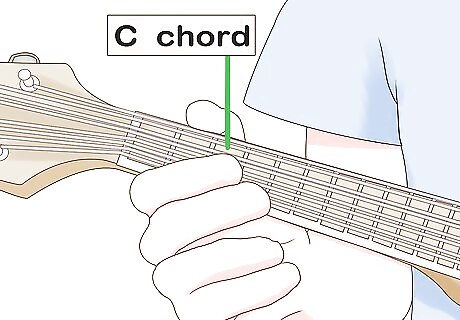
Move your fingers up one string to play a C chord. A C chord is played using the same chord shape as the G major chord. Move your fingers up one string so that your pointer finger is on the second fret of the D strings and your ring finger is on the third fret of the A strings. Strumming this shape while the top and bottom strings are open will create a C chord.
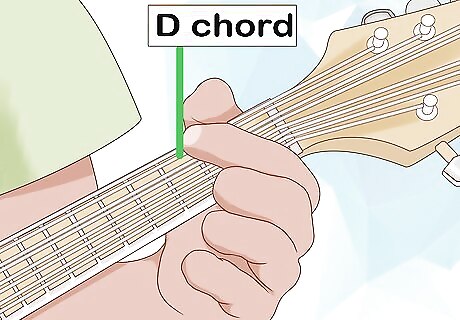
Put your fingers on the second fret of the E and G strings for a D chord. Unlike the C and the G chords, the D chord has a completely different shape. Place your pointer finger on the second fret of the G strings and your middle finger on the second fret of the E strings to play a D chord.
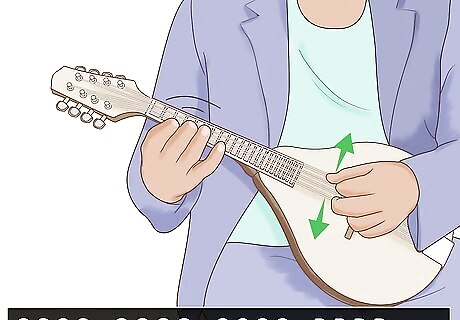
Practice transitioning between different chords. Once you get the chord shapes down and can create a good sound, practice going back and forth between a C and G chord. These chords are easier to transition to because they have the same shape. Strum four times on the C chord, then transition to the G chord and strum four more times. Then, when you feel comfortable, you can start mixing in the D chord in your progression. For example, you can hold each note for one beat and play C-C-C-C, G-G-G-G, C-C-C-C, D-D-D-D, C-C-C-C, G-G-G-G.
Learning Different Songs
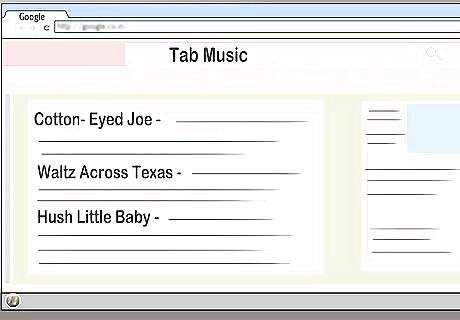
Get simple tab music. Search online for mandolin tab music and find simple songs that you can play. Easy songs to learn at first include children's songs and nursery rhymes. Look for music that only uses a couple of different chords and notes. Master these simple songs before moving onto more complex pieces. Some simple mandolin songs include "Cotton-Eyed Joe," "Waltz Across Texas," and "Hush Little Baby."

Play along with music. Tabs will show you the fingerings for songs but won't tell you the rhythm or how long you should hold each chord or note. For that reason, it will be easier to learn different songs once you listen to them. Purchase the music for the song you're playing and listen to it while you practice. With enough practice you'll eventually be able to play songs by ear.
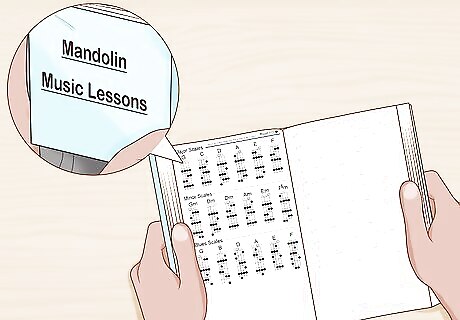
Learn how to play different scales. Learning the different scales will help you practice your mandolin fingering and will also teach you some basic music theory. For instance, the G major scale is G, A, B, C, D, E, and F♯. You can find examples of other major and minor scales online or in a mandolin music lesson book.
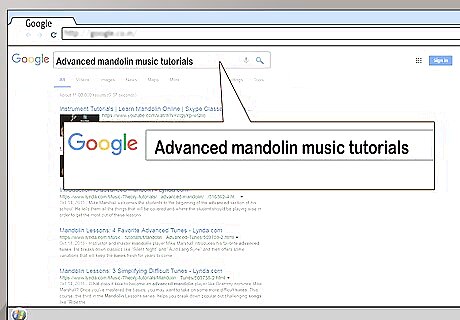
Search online for more advanced tutorials once you are confident in your playing skills. Once you can play a couple of songs from tabs, you'll want to move onto more complex content. Learn how to read music and look online to find more complex soloing tutorials. Find different, more difficult chords and scales to play and keep practicing until you can play songs without messing up.















Comments
0 comment